WEEKEND CROWDSOURCING EVENT YIELDS HOLOCAUST MUSEUM HOUSTON NEW OLD ARTIFACTS AHEAD OF ITS GRAND REOPENING  Note: This story previously stated that the museum had accepted artifacts as donations over the weekend. While the museum has agreed to consider certain items further as donations, it has not officially accepted any of them yet.
Owners of Holocaust-era documents, photographs, and other Jewish WWII memorabilia made their way out to Holocaust Museum Houston’s temporary location in a Kirby Dr. office park south of 610 yesterday between noon and 5pm where curators scrutinized their belongings and — in some cases — agreed to consider them further as potential donations. If accepted, the new artifacts would help fill up the museum’s more permanent home at 5401 Caroline St., which is scheduled to reopen in June having more than doubled in size to 57,000 sq.-ft. since last year. At least 2 of its mainstay exhibits are already there: a 25.7-ft.-long German rail car like those used to carry Jews to their deaths during the war and a 37.1-ft Danish fishing boat of the type used to rescue thousands of them in 1943. After being moved over to an adjacent lot in early last year, a crane airlifted the 2 vessels back onto the grounds of the museum in May so that a new portion of the campus they belong to could be built around them as part of the expansion. [Previously on Swamplot] Rendering of museum expansion: Holocaust Museum Houston
Note: This story previously stated that the museum had accepted artifacts as donations over the weekend. While the museum has agreed to consider certain items further as donations, it has not officially accepted any of them yet.
Owners of Holocaust-era documents, photographs, and other Jewish WWII memorabilia made their way out to Holocaust Museum Houston’s temporary location in a Kirby Dr. office park south of 610 yesterday between noon and 5pm where curators scrutinized their belongings and — in some cases — agreed to consider them further as potential donations. If accepted, the new artifacts would help fill up the museum’s more permanent home at 5401 Caroline St., which is scheduled to reopen in June having more than doubled in size to 57,000 sq.-ft. since last year. At least 2 of its mainstay exhibits are already there: a 25.7-ft.-long German rail car like those used to carry Jews to their deaths during the war and a 37.1-ft Danish fishing boat of the type used to rescue thousands of them in 1943. After being moved over to an adjacent lot in early last year, a crane airlifted the 2 vessels back onto the grounds of the museum in May so that a new portion of the campus they belong to could be built around them as part of the expansion. [Previously on Swamplot] Rendering of museum expansion: Holocaust Museum Houston
Tag: Museum District
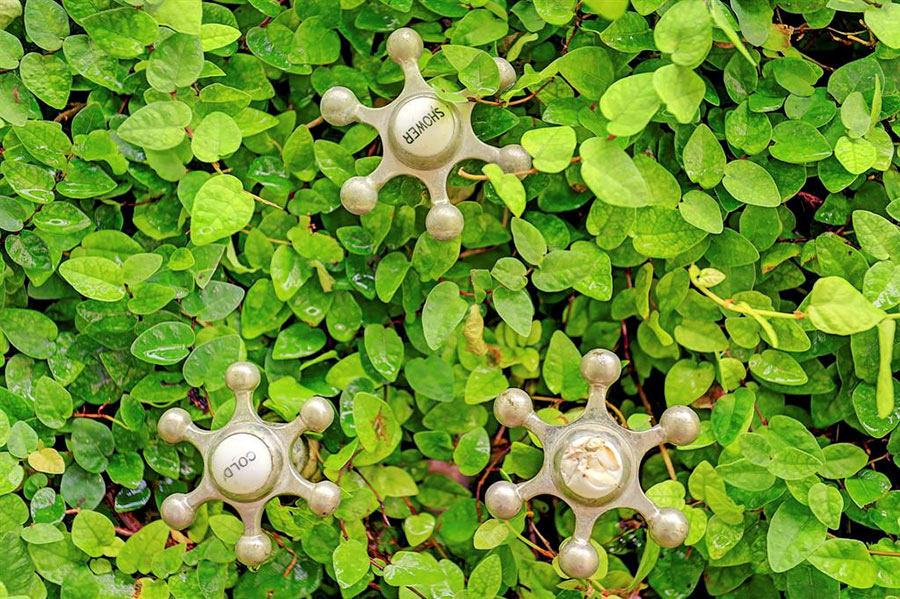
- 2 W. 11th St. [HAR]
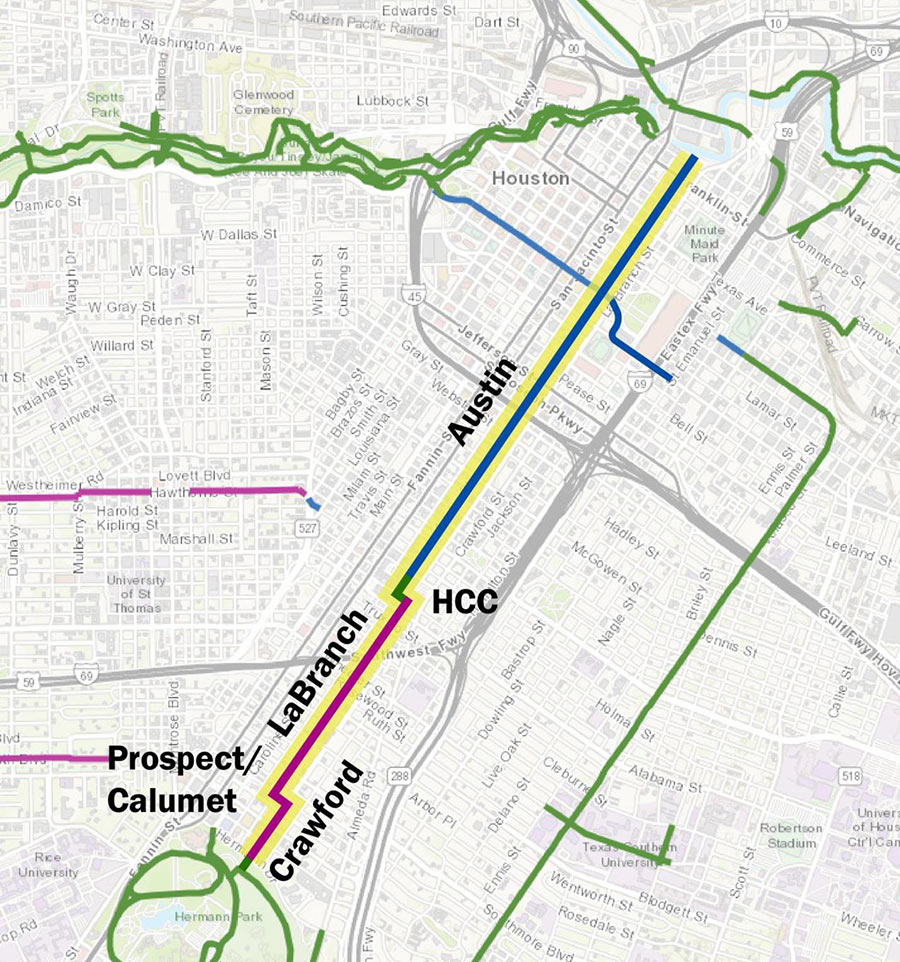
Last night Houston’s planning and development department spelled out a proposal to run a new pair of protected bike lanes on Austin St. from Buffalo Bayou to HCC’s main campus in Midtown. South of the college, the officially-designated bike route would continue down to Hermann Park along La Branch and Crawford streets but without anything to buffer it from the rest of the road.
Throughout Downtown and the northern portion of Midtown ending at McGowen St., plans show the bike lanes separated from the street by 2-ft.:
AN OPENING-NIGHT BRAWL AT CAM STARTED WITH A FEW LOAVES OF BREAD 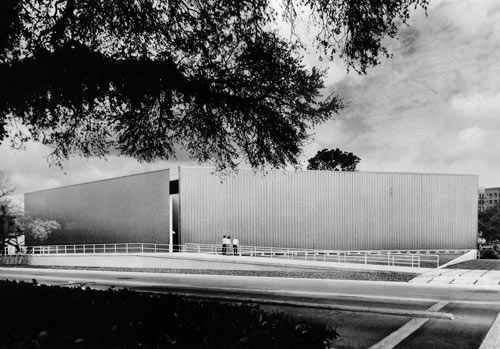 One highlight of Pete Gershon’s new book about Houston’s ’70s and ’80s art scene is his description of the all-out melee that erupted in the Contemporary Arts Museum’s upper gallery at the opening night of an exhibition put on by Spanish artist Antoni Miralda in 1977. Notorious for his work with food, Miralda, writes Gershon, had “hung color photographs of brightly hued macaroni, labeled huge mounds of salt and sugar with garishly flashing neon signs, and showed videos . . . of food being prepared and eaten in restaurants from around Houston.” The centerpiece was “four thousand loaves of bread dyed with food coloring” which performers placed “on a 175-foot row of benches bisecting the exhibition space.” Following some nibbling and “the playful tossing of slices,” one “notorious troublemaker from the St. Thomas art crowd,” picked up a loaf and chucked it carelessly, hitting a 6-year-old girl and knocking her to the ground. A fellow attendee dragged him out the back entrance to teach him a lesson, but it was too late: “inside the gallery the scene quickly escalated to a full-scale, Texas-sized donnybrook, with flying bread and flying fists.” Fifteen minutes later, management had cleared the room “and mopped up the blood,” adds the museum’s then-director. But his boss worried about the mark it’d left — not just in the minds of those who disapproved but, worse, the ones who “eagerly entered the fray.” Perhaps, writes Gershon, “they thought this happened at CAM all the time.” [Arts and Culture Texas; interview with Pete Gershon] Photo: Contemporary Arts Museum Houston
One highlight of Pete Gershon’s new book about Houston’s ’70s and ’80s art scene is his description of the all-out melee that erupted in the Contemporary Arts Museum’s upper gallery at the opening night of an exhibition put on by Spanish artist Antoni Miralda in 1977. Notorious for his work with food, Miralda, writes Gershon, had “hung color photographs of brightly hued macaroni, labeled huge mounds of salt and sugar with garishly flashing neon signs, and showed videos . . . of food being prepared and eaten in restaurants from around Houston.” The centerpiece was “four thousand loaves of bread dyed with food coloring” which performers placed “on a 175-foot row of benches bisecting the exhibition space.” Following some nibbling and “the playful tossing of slices,” one “notorious troublemaker from the St. Thomas art crowd,” picked up a loaf and chucked it carelessly, hitting a 6-year-old girl and knocking her to the ground. A fellow attendee dragged him out the back entrance to teach him a lesson, but it was too late: “inside the gallery the scene quickly escalated to a full-scale, Texas-sized donnybrook, with flying bread and flying fists.” Fifteen minutes later, management had cleared the room “and mopped up the blood,” adds the museum’s then-director. But his boss worried about the mark it’d left — not just in the minds of those who disapproved but, worse, the ones who “eagerly entered the fray.” Perhaps, writes Gershon, “they thought this happened at CAM all the time.” [Arts and Culture Texas; interview with Pete Gershon] Photo: Contemporary Arts Museum Houston
COMMENT OF THE DAY: ANOTHER MFAH STICKER SOLUTION 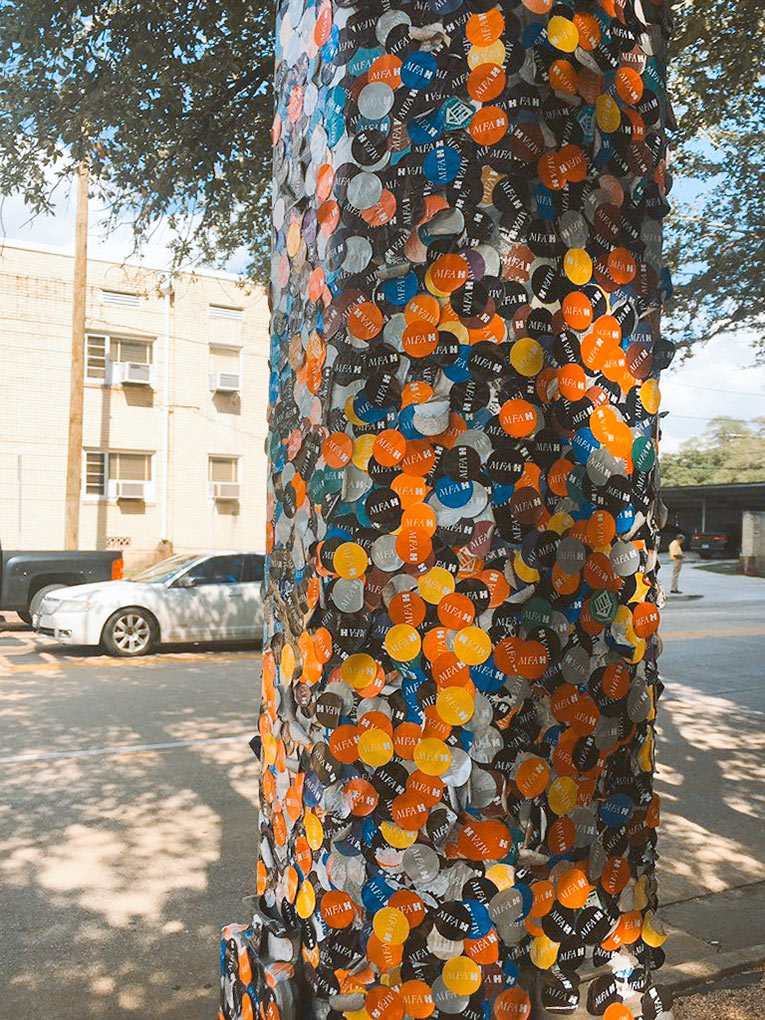 “It will be a sad day in Houston when there are no MFAH stickers stuck to things in the Museum District. You’d think that the museum long ago would have embraced the tradition and added some weird sculpture-looking things in front of all exits that say ‘stick stickers here.’ It would reduce the occurrences of random vandalism by hoodlums. I wonder how many tags they expect to ‘lose’ as part of this experiment?” [toasty, commenting on Flood Bond Passes; Harvey Movie Sets Its Premiere Date; MFAH Stickers Swapped Out for Reusable Tags] Photo of sticker collage at Binz and San Jacinto streets: Alley Lyles
“It will be a sad day in Houston when there are no MFAH stickers stuck to things in the Museum District. You’d think that the museum long ago would have embraced the tradition and added some weird sculpture-looking things in front of all exits that say ‘stick stickers here.’ It would reduce the occurrences of random vandalism by hoodlums. I wonder how many tags they expect to ‘lose’ as part of this experiment?” [toasty, commenting on Flood Bond Passes; Harvey Movie Sets Its Premiere Date; MFAH Stickers Swapped Out for Reusable Tags] Photo of sticker collage at Binz and San Jacinto streets: Alley Lyles
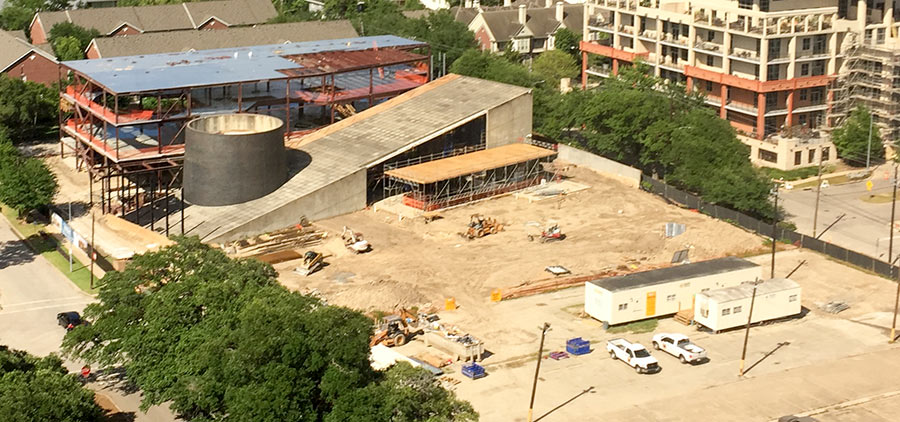
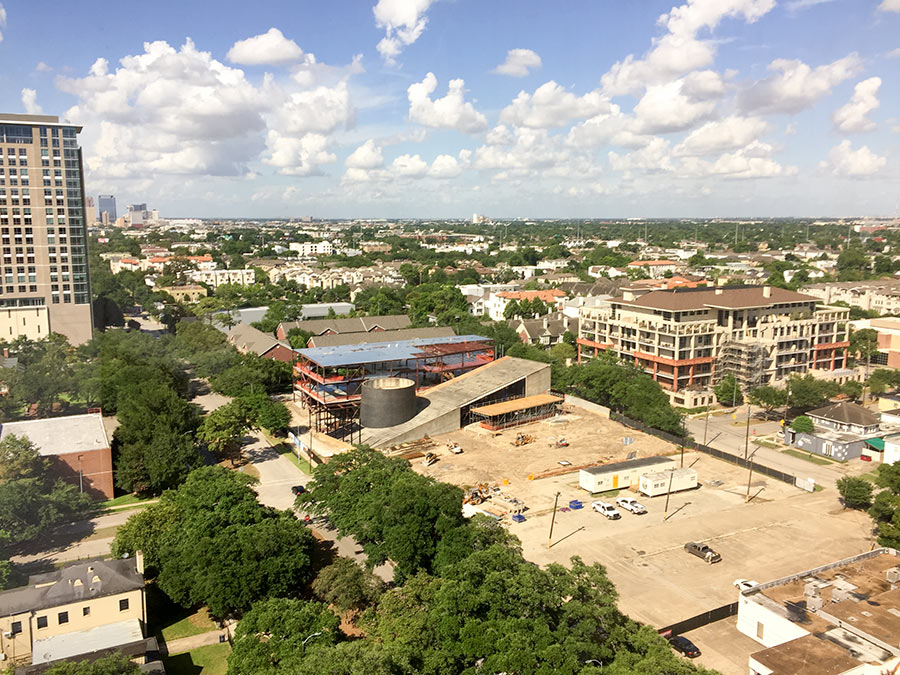
Photos from the 13th floor of the office tower at 1200 Binz St. look northeast to show the state of things at Holocaust Museum Houston’s construction site off Caroline St. Peeking out behind the chimney-like roof cylinder on the existing wedge-shaped building, you can seek 3 stories of steel now standing behind it. They make up a nearly three-times-larger structure now taking shape where the museum’s previous single-story northern building was torn down earlier this year. In its place, the new 57,000- sq.-footer designed by Mucasey & Associates will house a 200-seat theater, bigger exhibition spaces, more classrooms, a larger library, and more offices than its predecessor.
It’ll abut the existing ramped building as shown in the elevation below, with an entrance in between the 2:


During- and after-school views east across Oakdale St. show the 4-story, Gensler-designed school building that First Presbyterian Church plans to build adjacent to its current one in the Museum District. The new building is tucked into the pie slice of streets and parking lots north of the MFAH between Montrose Blvd. and Main. It sits on 2 vacant lots totaling just under one fifth of an acre in the loop formed by Oakdale and Pinedale streets. Catty-corner to it is the existing First Presbyterian School’s driveway — visible at the bottom of the daytime view above.
A sliced-open view from the building’s backside shows its lobby fronting the existing pre-K-through-8 school:

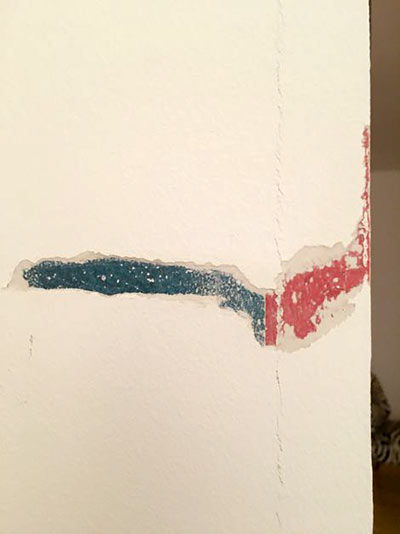
How’s this for a twisting story line? An architect commissions a famous artist to create a site-specific drawing in a house he has built for himself. The artist, who never touches his own works, creates exacting instructions that installation artists follow to create the 30-ft.-tall artwork in the living room of the home. The artist dies. A few years later, the architect dies, offering his home and the majority of his extensive art collection to a local but world-famous museum of which he was a trustee. The museum decides to sell the home and add much of the art to its collection, but there’s a problem with the wall drawing. It can’t be moved, and the museum is stymied by a restriction: It is not allowed to sell any artwork that has been bequeathed to it.
Here’s where the plot — and the drywall mud — thickens: the museum, unable to remove the artwork from the home without destroying it, comes up with an alternative plan. It will plaster over the drawing, rendering it unrecoverable.
Years later, the purchaser of the home is telling this story to a houseguest — who in a fit of curiosity grabs a dull knife and starts chipping away at the wall. The white coating flakes off. To his and his host’s surprise, a tableau of blue, red, and yellow appears: a fragment of the original drawing underneath.
What is this? The first 20 minutes of a new Wes Anderson movie, an episode of Columbo, or the setup for a Siri Hustvedt novel? No, its just the state of play at 1202 Milford St. in the Museum District. The artist is Sol LeWitt. The museum is the Menil Collection. The home is the former residence of Houston architect Bill Stern. And the plotline is still in progress:
GUNNAR BIRKERTS, 1925-2017 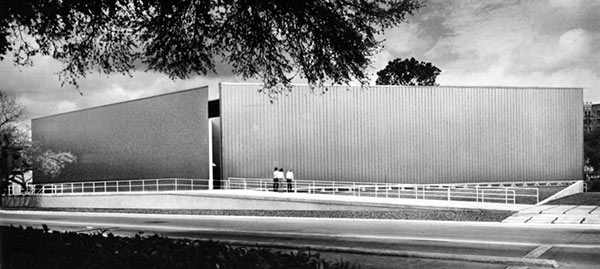 Latvian-born architect Gunnar Birkerts, designer of the stainless-steel-clad Contemporary Arts Museum that’s stood at the northwest corner of Montrose Blvd. and Bissonnet St. since 1972, passed away yesterday at the age of 92. Birkerts moved to Michigan in 1949 after graduating from architecture school in Germany; he later worked in the office of Eero Saarinen and set up his own architectural practice in Birmingham, a Detroit suburb. The exterior of the CAMH was altered to its current appearance in 1997 after a design by Houston architect Bill Stern. [Chicago Tribune; more here] Photo: CAMH
Latvian-born architect Gunnar Birkerts, designer of the stainless-steel-clad Contemporary Arts Museum that’s stood at the northwest corner of Montrose Blvd. and Bissonnet St. since 1972, passed away yesterday at the age of 92. Birkerts moved to Michigan in 1949 after graduating from architecture school in Germany; he later worked in the office of Eero Saarinen and set up his own architectural practice in Birmingham, a Detroit suburb. The exterior of the CAMH was altered to its current appearance in 1997 after a design by Houston architect Bill Stern. [Chicago Tribune; more here] Photo: CAMH
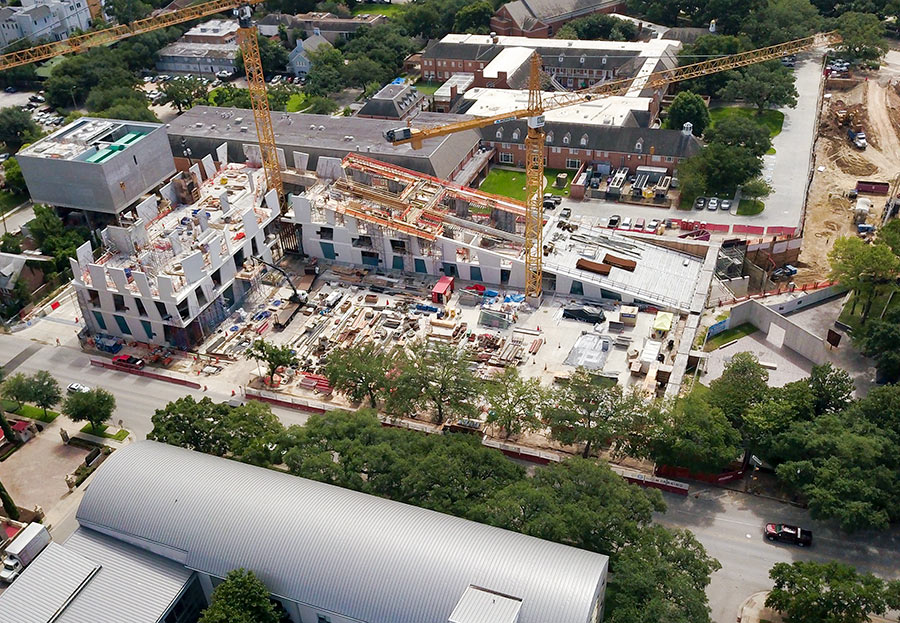
From the skies above Montrose Blvd. just north of Bissonnet, here’s a view from late last week of progress on the Museum of Fine Arts Houston’s new Glassell School of Art. The new building, designed by Steven Holl Architects, is under construction across the street from the Glassell Junior School building (in the foreground, with the curved roof) — and on the same site where the original Glassell School, designed by Houston architect S.I. Morris, was demolished in 2015. Morris’s Glassell School featured exterior walls of glass block; the primary exterior materials of Holl’s replacement building are sandblasted panels of precast concrete, assembled to shape an inclined plane along the long edge of the building’s L shape.
If that part of the building is starting to look like it’ll form a giant ramp, it’s because it will: Models of the structure show an outdoor amphitheater at the ramp’s base; a rooftop public path will ascend beyond it to a sculpture garden on the roof of the building’s northern leg. An addition to the existing sculpture garden to the south will extend into the courtyard shaped by the building’s two wings, fronting Montrose Blvd. The space designated for the garden is filled with construction materials in the center of the photo above; it’s pictured in a more completed state in this rendering by the architect:
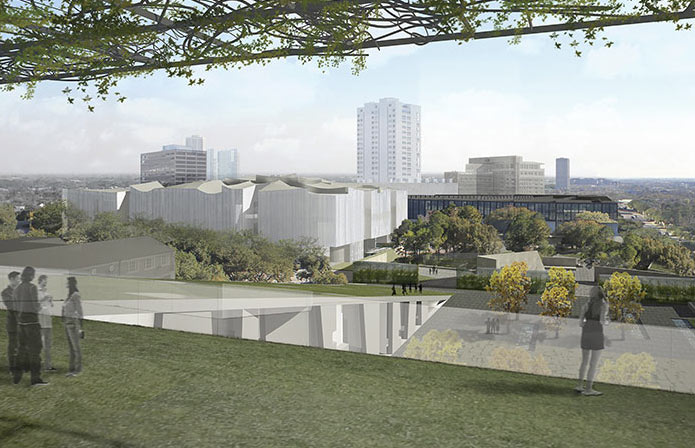
Construction started yesterday on the Nancy and Rich Kinder Building, going up in the Museum of Fine Arts Houston’s former parking lot north of Bissonnet St. at Main. That’s the curvy-roofed structure itself visible in the rendering above — the drawing shows the expected view of the building from the rooftop garden of the already-under-construction nearby replacement for the formerly glass-covered Glassell School (whose underground parking garage opened up when the surface lot closed last week). Both of the new buildings were designed by Steven Holl Architects — here’s where they fall on the map, along some of the other big changes in the works for the Museum’s campus:
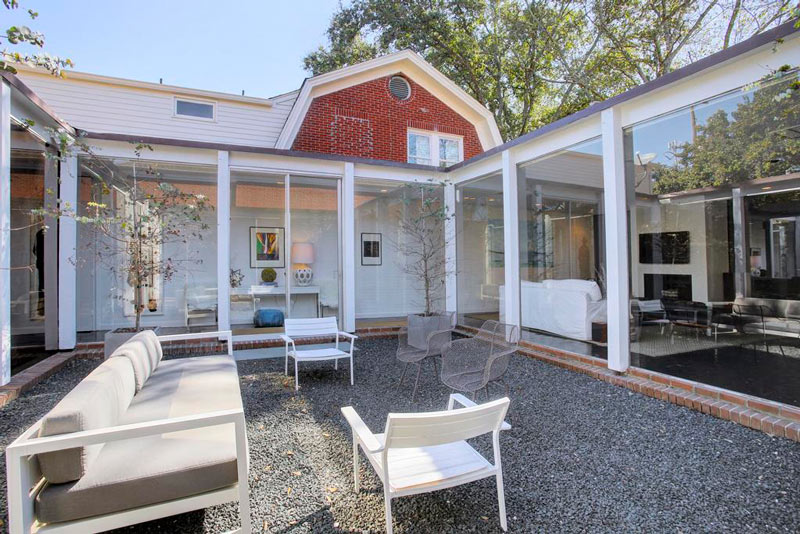
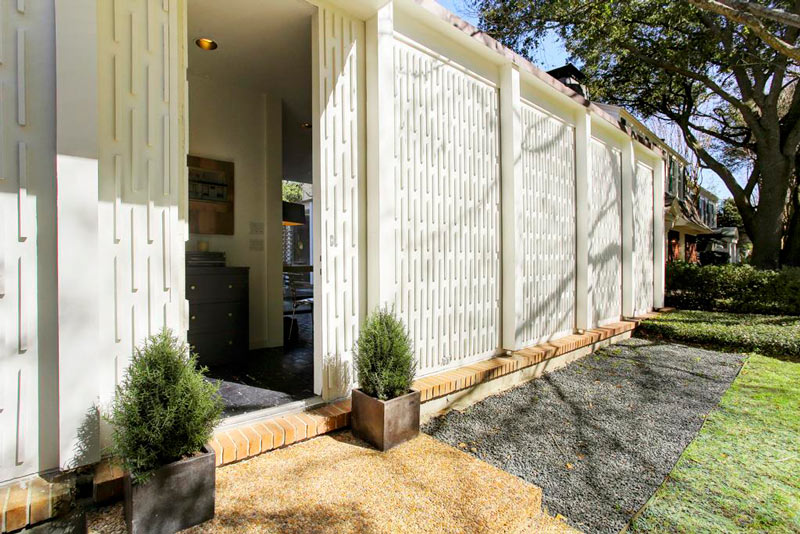 On the market again: the designed-it-himself 1959 home of Ralph Anderson (who worked on the Astrodome, as well as the retooled brutalist building now occupied by the Houston Chronicle). The home is iced on its Banks St. side in cream-colored patterned concrete and contains an airy courtyard center; the latest asking price is $839,000, down from $875,000 last spring. The property was a stop on houstonMod’s May Mod of the Month tour, which took place yesterday afternoon.
On the market again: the designed-it-himself 1959 home of Ralph Anderson (who worked on the Astrodome, as well as the retooled brutalist building now occupied by the Houston Chronicle). The home is iced on its Banks St. side in cream-colored patterned concrete and contains an airy courtyard center; the latest asking price is $839,000, down from $875,000 last spring. The property was a stop on houstonMod’s May Mod of the Month tour, which took place yesterday afternoon.
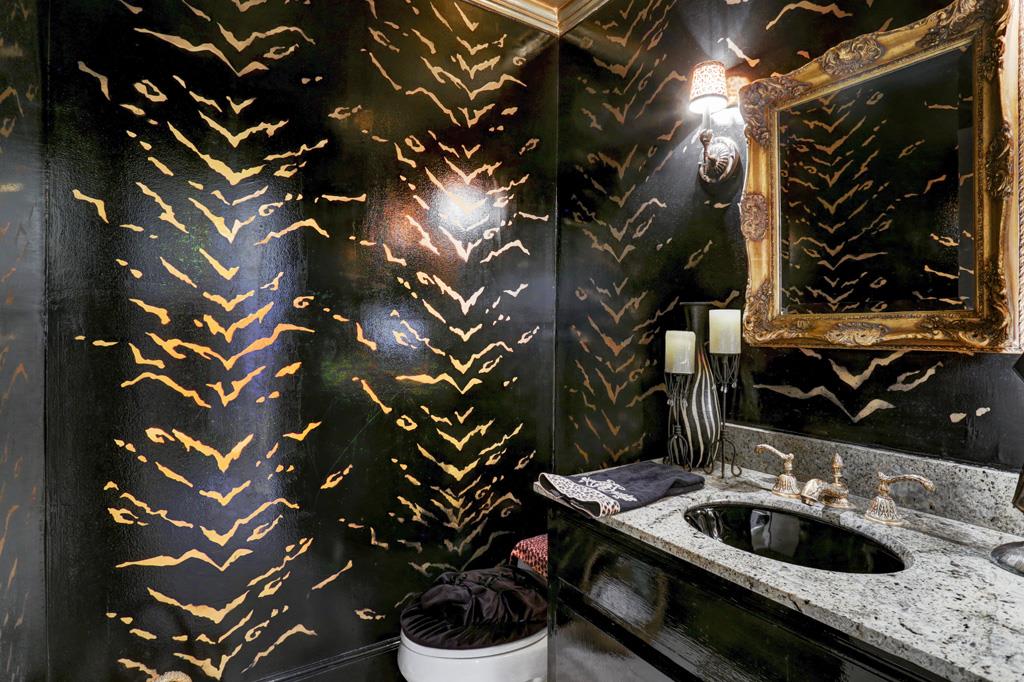
- 4 W. 11th Pl. [HAR]
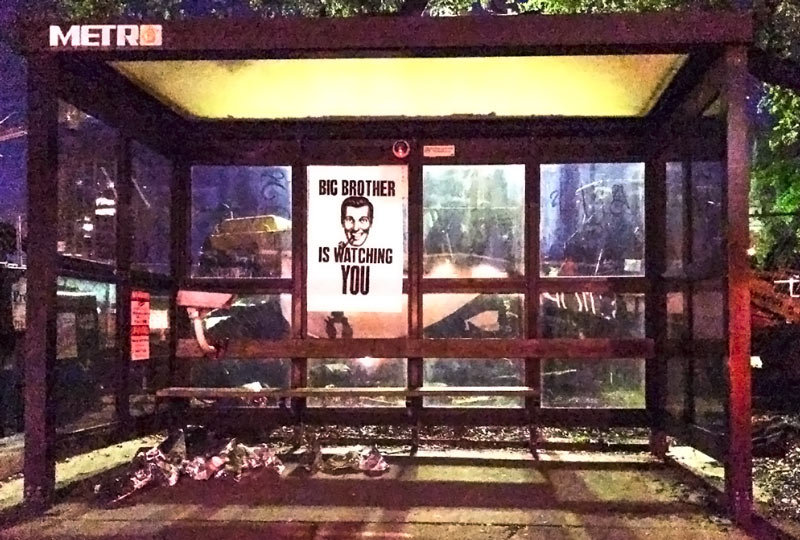
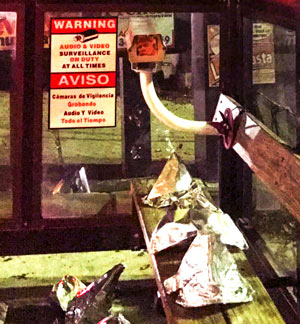 Shots of Orwellian wall ornamentation and conspiracy theorist headgear were turned up by a reader’s surveillance of the Bissonnet St. bus shelter east of Montrose Blvd. by the Museum of Fine Arts early Saturday morning. The setup looks like one of the series of bus shelter makeovers purportedly planned around town by a vigilante redecorator — though perhaps because of heightened citywide gag tolerance spurred by April Fool’s Day, this round seems to have significantly outlasted the pre-dawn tiki hutch installed in front of the Public Storage on W. Gray back in February.
Shots of Orwellian wall ornamentation and conspiracy theorist headgear were turned up by a reader’s surveillance of the Bissonnet St. bus shelter east of Montrose Blvd. by the Museum of Fine Arts early Saturday morning. The setup looks like one of the series of bus shelter makeovers purportedly planned around town by a vigilante redecorator — though perhaps because of heightened citywide gag tolerance spurred by April Fool’s Day, this round seems to have significantly outlasted the pre-dawn tiki hutch installed in front of the Public Storage on W. Gray back in February.
Eyes on the scene sent a few further monitoring reports on the decorations throughout the day, including notes of edits to the display from various passer-bys:
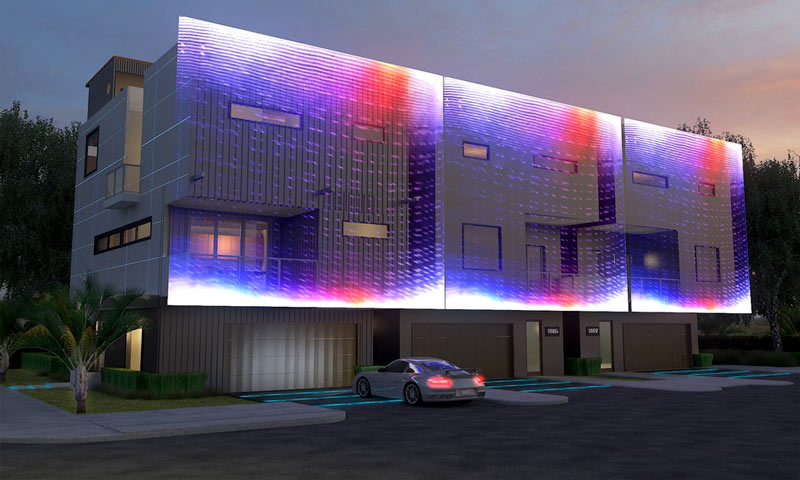
Like the looks of this light-display-slash-townhouse-trio at Prospect and Chenevert streets on the Almeda side of the Museum District? All 3 of the homes hit the market yesterday for between $925,000 and $975,000 (that’s 5313 Chenevert, 1805 Prospect, and 1807 Prospect, from left to right). Developer Dreamscape Modern posted the (rendered) view above to its website for Phase 2 of its The Art Colony townhouse development, which includes a see-through panel to catch shifting colored light projected onto the house after dark.
The light displays shown in the rendering and in the video above are a bit more intricate than the particular pattern shown in the new listing photos — though the illuminated driveway strips appear to be the same shade of aqua, amid the xeriscaping in place of the grass lawns originally depicted:

